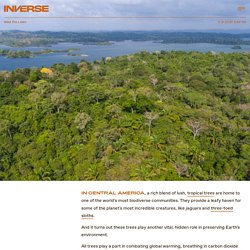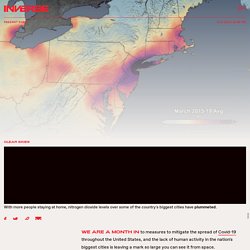

This device captures the carbon from trucks as they drive. ‘Our biggest challenge? Lack of imagination’: the scientists turning the desert green. Asbestos could be a powerful weapon against climate change (you read that right) On a scorching day this August, Caleb Woodall wielded his shovel like a spear, stabbing it into the hardened crust of an asbestos-filled pit near Coalinga, California.

Woodall, a graduate student at Worcester Polytechnic Institute in Massachusetts, was digging out samples from an asbestos mine that’s been shuttered since 1980, a Superfund site on the highest peak in the state’s Diablo Range. He extracted pounds of the material from several locations across San Benito Mountain, shoveled them into Ziploc bags, and shipped them to a pair of labs for analysis. Bacterial biofilm wrings oil out of water. Once oil gets into water, it can be difficult to separate the two, which can make polluted water tricky to clean up.

Now, researchers at North Carolina (NC) State University have found that a bacterial biofilm membrane can effectively let water through while keeping oil out. Oil can be a major environmental hazard. Obviously that includes huge oil spill disasters like Deepwater Horizon, but even on smaller scales contamination can occur from industrial processes. Cold Spring Harbor Lab on Nautilus: How to Bury Carbon? Let Plants Do the Dirty Work. Forty-nine million years ago, a small aquatic fern called Azolla wrested control of Earth’s climate.

At the time, the landlocked Arctic Ocean developed a surface layer of freshwater, which allowed the ferns to grow unchecked in a wide-open environment. Billions of tons of plants died and sank to the bottom of the ocean, taking with them the carbon they had sucked from the air when they were alive. The consequences were extreme. Geologic evidence indicates that atmospheric carbon dioxide levels plummeted more than 80 percent over 800,000 years, sharply ratcheting down Earth’s thermostat. Can a Pro Snowboarder Disrupt a $100 Billion Industry? Alex Yoder spent his twenties chasing snow around the world.

A sponsored snowboarder for Patagonia, he grew apathetic to token acts of environmental activism, like social posts and climate marches. “They felt hollow," he recalls. “I wanted a tangible role in actual impact and became interested in regenerative organic farming. 'One of a kind': calls to protect Alabama's 60,000-year-old underwater forest. When divers jump into a particular stretch of water off the coast of Alabama, they travel back to a time before humans arrived in the new world.

Submerged below the waters are the remains of a cypress tree forest that grew 60,000 years ago, but was inundated by the Gulf of Mexico and preserved from decomposition beneath sediment. Mose flood barrier protects venice from rising storm tide for first time. 3D printed terra cotta tiles restore devastated coral reefs. Scientists may have ignored a secret weapon against climate change. In Central America, a rich blend of lush, tropical trees are home to one of the world's most biodiverse communities.

They provide a leafy haven for some of the planet's most incredible creatures, like jaguars and three-toed sloths. And it turns out these trees play another vital, hidden role in preserving Earth's environment. All trees play a part in combating global warming, breathing in carbon dioxide and storing it in the ground. But when it comes to how effectively they carry out this environmental role, not all trees are created equal. In a new study of Panama's tropical forests, researchers modeled forest demographics using a dataset spanning 40 years and nearly 300 tree species.
Protecting these trees is vital to the planet’s future, the researchers say. Current climate-change forecasts tend to treat all trees equally, but this study suggests some should be taken into greater account than others, fundamentally altering the forecast models. Henning Rogge: History Based Landscapes. ©Henning Rogge, #41 (Rotterbach und Hacksiefen) I must admit, I do not know a lot about Henning Rogge, nor do I know much about his work beyond what I can see in the images.

But what I see I absolutely love, and so, I reached out to Henning, who is based in Hamburg and asked if I could include his work here, to which he graciously agreed. I first came across this series, titled Bombenkrater (Bomb Craters), some years ago in the New York Times Lens Blog. The images are serene color photographs of wooded areas that each contain a similar round depression in the ground made by bombs in the Second World War. Rising Sea Levels - Shrinking Coastlines. At MIT's Self-Assembly Lab, researchers are working to rebuild islands in the Maldives by harnessing the power of ocean waves.

Using underwater sand bags, the scientists figured out that ocean waves will crash over them and redistribute the sand to form new mounds.It's a way to work with nature, rather than against it, to protect coastal communities. Over the past 100 years, sea levels have risen between 6 and 8 eight inches globally, with half of the increase occurring over the last three decades, according to NASA. And with about 40 percent of the world's population living in coastal areas, those rising tides will continually threaten peoples' homes, say researchers at the Massachusetts Institute of Technology's Self-Assembly Lab. Static physical barriers and ongoing coastal dredging simply won't solve the problem, the scientists say. So instead, their goal is to "work with the forces of nature, harnessing them to build rather than destroy. " The Tragedy of the Compost. There are a lot of nice stories circulating about the return of wildlife and the healing of nature as humans pause our activity.

However, this slowdown is not all good news for the environment. New York City, for example, has suspended its organic recycling program. Flash Forest is using drones to plant tens of thousands of trees. NASA reveals a dramatic, hidden effect of coronavirus on the United States. We are a month in to measures to mitigate the spread of Covid-19 throughout the United States, and the lack of human activity in the nation's biggest cities is leaving a mark so large you can see it from space.

On Thursday, NASA released new satellite data revealing a dramatic reduction in the levels of nitrogen dioxide over metropolitan areas of the Northeast US. These are the lowest monthly atmospheric nitrogen dioxide levels recorded over the region since 2005, when NASA's Ozone Monitoring Instrument (OMI) began operating. Overall, the nitrogen dioxide levels in March 2020 are about 30 percent lower than they were compared to the average levels recorded from March 2015 through March 2019.
These charts showing average levels from the past five years show just how stark the difference really is: And today: The above visualization covers across the region of the I-95 corridor, revealing air pollution levels above cities such as Washington, D.C., New York, Boston, and Philadelphia. Water In Venice Canals Goes Crystal Clear After Coronavirus Lockdown. Where pessimists see a half-empty glass, optimists come along to show that it’s actually half-full.
Same goes for the ongoing chaos of the coronavirus—while some are hoarding away toilet paper like there’s no tomorrow, there are people who see positive outcomes even in a situation as dire as this. One of these positive outcomes is that pollution has dropped down dramatically following the lockdown of Italy. Scientists and researchers agree on the spotted significant decrease in NO2 levels above the country. Microsoft’s Moonshot Plan to Reverse Its Lifetime CO2 Emissions by 2050. The alarming headlines about Australia’s bush fires over the last couple weeks have heightened the global outcry over climate change, and companies, NGOs, and governments are taking action. One of the most ambitious targets was set last week by Microsoft. In a press conference on January 16, CEO Satya Nadella announced that not only does the company plan to be carbon negative by 2030, but if it succeeds, the move will effectively cancel out its lifetime CO2 emissions by 2050.
'Mother Nature recovers amazingly fast': reviving Ukraine's rich wetlands. A battered old military truck and rusting Belarusian tractor are perched on the edge of degraded wetland in the heart of the Danube Delta Biosphere Reserve. First Human Composting Site Coming to Seattle. After receiving a Nobel Peace Prize nomination and launching global strikes for the environment, Greta Thunberg has something new to add to her list of accomplishments. Daan Roosegaarde creates a "smog-eating billboard" in Mexico. 5 things to know about fighting climate change by planting trees. Ocean Cleanup takes on rivers of plastic with "The Interceptor" Ocean Cleanup starts harvesting plastic from the Great Pacific Garbage Patch.
After years in development, the Ocean Cleanup arrived at the Great Pacific Garbage Patch in October last year with the intention of gathering up plastic waste. Student Treks to Yellowstone and Finds Bacteria That Eats Pollution and ‘Breathes’ Electricity. This Tasty Seaweed Reduces Cow Emissions by 99%—and It Could Soon Be a Climate Gamechanger. Teenager wins $50,000 award for extracting 87% of microplastics from water using magnetic liquid.
The Cheapest Way to Save the Planet Grows Like a Weed. Restoring forests could capture two-thirds of carbon humans have added to the atmosphere. 40 tons of fishing nets retrieved in Pacific Ocean cleanup. SAN FRANCISCO (AP) — In a mission to clean up trash floating in the ocean, environmentalists pulled 40 tons (36 metric tons) of abandoned fishing nets this month from an area known as the Great Pacific Garbage Patch. The Ocean Cleanup redeployed to tackle Great Pacific Garbage Patch. A floating device employed by The Ocean Cleanup project has been upgraded and returned to sea in a second attempt to catch the plastic waste circulating in the Pacific Ocean. Iceland’s Radical Plan to Slow Climate Change. Photographer And His Wife Plant 2 Million Trees In 20 Years To Restore A Destroyed Forest And Even The Animals Have Returned.
Newly identified bacteria feeds on methane in the atmosphere. Great Green Wall — The Great Green Wall. Africa is building a wall—a wall of trees across the entire continent and it's changing the world. Real-world-ready artificial leaf can pluck carbon dioxide out of thin air. Packaging Is Killing Us, and the Holidays Are the Worst. Scientist's accidental discovery makes coral grow 40x faster. Wynd's Halo and Home Purifier get serious about cleaning the air in your home.
Moon Now Overrun With Cane Toads After Species Accidentally Introduced Into Environment During Apollo 17 Mission. Australian Town Comes Up With A Genius Way Of Stopping Pollution. The Ocean Cleanup Project moves to fix leaks in its first plastic-catching system. PARQ envisions volcanic machines that release steam clouds to reverse global warming. Sciencemag. Turtles Come Back To Indian Beach For The First Time In 20 Years After World’s Biggest Clean Up, Prove We Can Make A Difference.
Turning the Sahara Green: Scientists Announce Plan to Bring Vegetation to Desert With Mega Wind and Solar Farms. Ocean Cleanup system completed and ready to be towed out to sea. Can Hemp Clean Up the Earth? Untitled. Louisiana Wants To Use The Muddy Mississippi To Build Up Its Coast. Turns Out That ‘Boy Genius’ Who Said That He Could Make The Ocean To Clean Itself Was Right.
Scientists hope new enzyme will 'eat' plastic pollution. This Floating Platform Could Filter The Plastic From Our Polluted Oceans. Can tiny plankton help reverse climate change? – David Biello. 19-Year-Old Develops Cleanup Array To Remove 7,250,000 Tons Of Plastic From Oceans. Cleaning air the natural way. Shell to Test Capturing of Carbon in Canada. Asteroid Dust Cloud Could Act As Sunshade, Fight Climate Change On Earth, Researchers Suggest. How Cattle Grazing Can Reverse Desertification and Climate Change. Ocean Cleanup concept to become a reality next year. Ocean Cleanup project completes Great Pacific Garbage Patch research expedition. Cleaning ship emissions with metal sponge cells. Row-bot cleans dirty water and powers itself by eating microbes. This Genius Bucket Sucks Trash And Oil Right Out Of The Sea. Ocean Cleanup project to test its first trash-catching barriers in Dutch waters. Mutant grasses can clean up the mess left over from bombs.
Giant vacuum cleaner sucks up urban pollution. Preserving reef ecology by putting plastic in the ocean. 'Plastic-eating' fungus discovered in Islamabad garbage dump - Pakistan - DAWN.COM. Statoil ($STO), Shell ($RDSA), and Total have teamed up to store carbon dioxide in Norway's continental shelf — Quartz. ‘Sowing’ corals on degraded reefs could help large-scale restoration. Concrete pods promise faster reef restoration. NASA satellite shows direct evidence of ozone hole recovery.